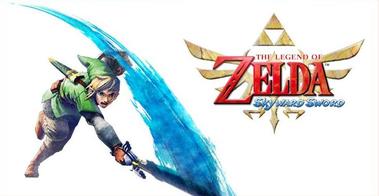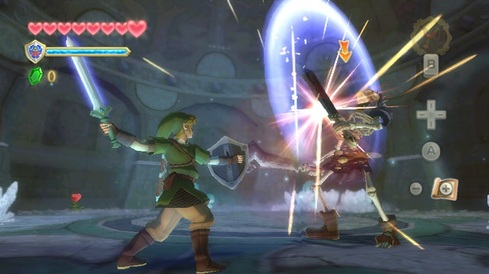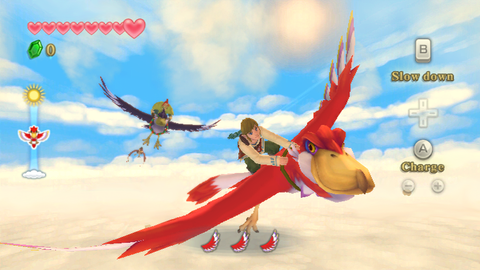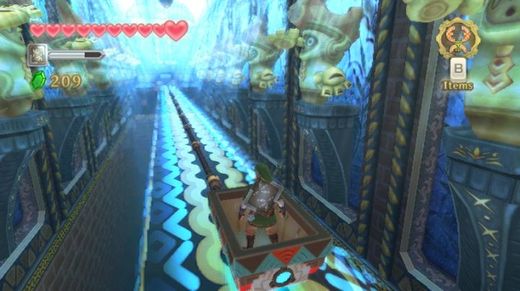
The latest iteration in the long-standing Zelda series, Skyward Sword, is the cultivation of five years of hard work and how motion gaming can be something other than gimmicky. Throughout my 30-plus hour experience, Nintendo was able to bring in the best aspects of Zelda, be it dungeon design, visuals, characters, gameplay, atmosphere, music, and even intriguing puzzles. This, along with the main development focus of Wii MotionPlus, separates Skyward Sword from its predecessors by making the entire adventure it a worthy challenger to the timeless Ocarina of Time.
Hit the jump to read the conclusion of the review.
As a prequel to Ocarina of Time, one would not expect story to be the main focus of Skyward Sword, considering Nintendo has opted not include voice acting once again (an omission that’s understandable to an extent). The story may seem familiar to any Zelda veteran: Link is thrown into conflict and must become the hero of destiny and save the damsel in distress before the world is thrown into ruin. While no sure surprises with that premise, Skyward Sword serves as a legit origin story to many important characters and things in the Zelda universe; the most obvious of these items being the legendary Master Sword.
The real selling point to this adventure though is the motion controls, which are nothing but pristine. With Wii MotionPlus, the one-to-one control gives one a feeling akin to waving a stick around as if it were a sword. That childhood comparison is enough to show how vivid and responsive each movement is on screen. The swordplay is different from any other Zelda title in recent memory. Each battle with a Lizalfo or Bokoblin becomes an exciting event that makes finding their specific weaknesses all the sweeter. For new players, waggling the Wiimote should not be the way to approach swordplay, as you will pay dearly for it.
The accuracy and precision are enough for me to declare that I would rather play a future Zelda title without the use of pressing a button. Wii MotionPlus evolves Zelda’s gameplay without making it feel outdated or stale. That alone gives the series a breath of fresh air, even if some tried-and-true mechanics rear their head from time-to-time. With that said, Skyward Sword’s one-to-one swordplay takes the Zelda series into new directions and with enough room to decipher for new ideas in future installments.
Now, like many 3D Zelda games, the game takes a bit of time for it to properly get moving forward. This is plagued by handholding moments that tend to thrive on a reiteration of text that’s sure to make one desire a sword and shield immediately. With that aside, once Skyward Sword’s adventure starts to roll, the action and puzzle solving start to shine.
Dungeons have also been slightly reworked to accommodate to the sky over world, which h. While the Skyward Sword employs only three major areas, each is layered with a new section and acts as a dungeon within a dungeon. So, basically you never know where a dungeon starts or begins. Off the top of my head, I counted seven dungeons, but with the new approach, you could say that there were around 14 to 18. As ridiculous as that seems, the layered dungeons set-up adds a new way of exploring without a break in the action. This is purely a new Zelda experience with its dungeons, puzzles and gameplay, despite it feeling slightly similar in design.
Visually, Skyward Sword won’t win any awards, considering how it’s running on old technology, but one would be willing to make an exception. Even with the Wii’s limitations, the game is still a sight to look at as you play. Skyward Sword offers a great balance of the cartoony, cel-shaded visuals from Wind Waker and the realistic tone from Twilight Princess. The mash-up between the two creates an impressionist style that allows for exaggerated enemy designs and whimsical area layouts. Now, there are a lot of blurry textures if you look close enough, but the visual style of Skyward Sword is like a painting come to life. As much as the series could benefit from an HD upgrade, Nintendo working the Wii’s aging processor at full blast is a reasonable decision.
Skyward Sword delivers on every bit of promise from Nintendo with its spot-on motion controls, subtle storytelling, impressionist art style, and ingenious dungeon designs that continue to turn heads. The boss battles are as epic and surprising as ever; the music is grander with a backing orchestra (do yourself a favor and download the soundtrack); and overall experience is one to behold. Skyward Sword isn’t just one of 2011’s best, it’s one of this generations finest examples of video game development. The Zelda formula may have started to show its age, but Skyward Sword proves that a franchise that’s celebrating its 25th anniversary can still strive in a world dominated by first-person shooters and western-developed RPGs. Nintendo has once again proved skeptics wrong, and one wonders how they can outdo themselves again. Dust off your Wii and experience an adventure that shows why Zelda is still relevant and worth an extra rupee.
9.5/10




 RSS Feed
RSS Feed
